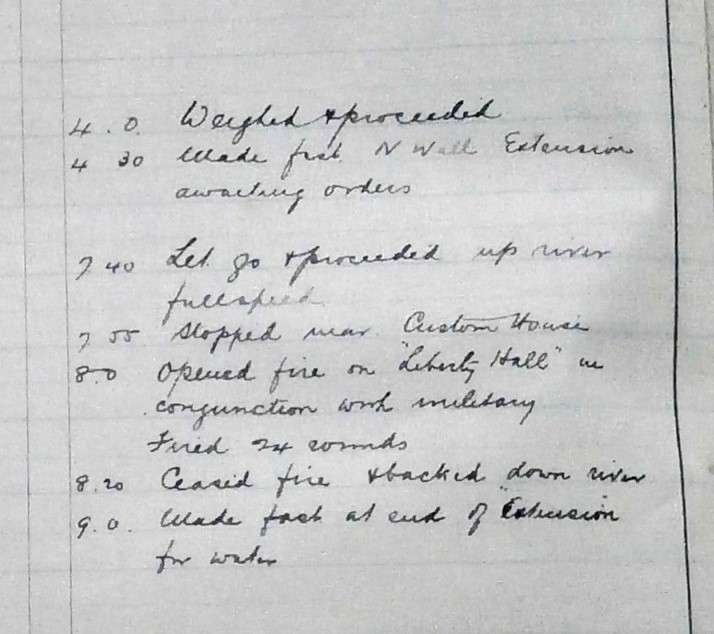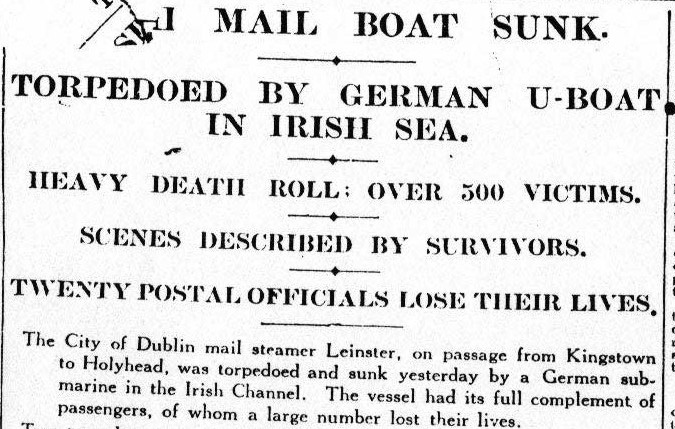‘I am Muirchú’
by
Rita Edwards

I am Muirchú the ‘Hound of the Sea’. I was not always known as Muirchú. When I was built in the Liffey Dockyard in Dublin in 1908 – a steam yacht with 323 tons displacement, capable of reaching a speed of 14.6 knots – I was named Helga II. There must have been a Helga I but I don’t know anything about her.
Helga is an Old German/Old Norse name which can mean ‘holy, sacred or successful’. When I was first launched I worked as a fishery protection vessel for the Department of Agriculture and Technical Instruction (Ireland). I spent my time patrolling the Irish coast protecting the fishing grounds.
Six years later I overheard the crewmen saying that the world was at war. In 1915 I was taken over by the English Admiralty and renamed HMY (His Majesty’s Yacht) Helga. I was then equipped with artillery and other guns on my deck. When they fired, the noise was deafening.
My work got harder. I now served as an anti-submarine patrol vessel. In April 1918 I attacked a German submarine off the Isle of Man. For the remainder of my career I carried a star on my funnel in recognition of my achievement. I remained on escort duty in the Irish Sea, making sure that other ships arrived safely at their destination.

Extract from Helga log , 25th April 1916
In April 1916 I left the sea and sailed up the River Liffey in Dublin where my guns shelled Liberty Hall and other buildings. Within a few days, with support from other artillery positions, the centre of the city was in flames.
Over two years later in October 1918 I was taking on fuel in Kingstown Harbour when the RMS Leinster, the Dublin-Holyhead mail-boat was torpedoed near the Kish Lightship by another enemy submarine. I sailed out the seven miles and brought ninety of the survivors back safely into harbour.

For a short time, I was back doing the work I loved – patrolling the Irish coast protecting the fishing grounds. However, no sooner had one war ended when another war began. From March 1920 I carried men in black and tan uniforms from one Irish port to another.
Then peace reigned for a while until June 1922 when there was another war and I was commandeered by a new Irish Free State to transport other men in dark green uniforms from one Irish port to another.
I grew tired of war. During all the years, in keeping with my name, sometimes my work was holy, sometimes it was sacred, sometimes it was successful – but all too often, it was simply profane.
Eventually in August 1923 I became the property the Free State and the new Irish Department of Agriculture and Fisheries and renamed the SS Muirchú – the Hound of the Sea. And once again, I was back patrolling the Irish coast protecting the fishing grounds.
But peace did not last. Sixteen years later in September 1939 the dogs of war were unleashed again. Up to then the Free State did not have a navy. Due to a lack of ships, I had the distinction of being one of the first ships in the new Irish navy in the Marine and Coastwatching Service.
I served faithfully until the end of that war, by which time the marine service had ten sea-going ships. Then it became apparent that I had outlived my usefulness. For a time I was kept in dry dock in Cobh in Co Cork. Then I overheard that I was to be decommissioned and sold to Hammond Lane Foundry in Dublin.
On the 8 of May 1947 which was the day appointed for me to make my final voyage to Dublin Bay I decided that for once I would take control of my own fate. As I approached the Saltee Islands off Kilmore Quay in County Wexford, I loosened the rivets in my bow just below the waterline. In a short time, I started to list. I waited until the crew had time to abandon ship and then slowly, I sank beneath the waves.
After all, I am Muirchú– the hound of the sea and it is fitting that I should rest on its welcoming bed, instead of being brought to Dublin – the place where I first felt cool water against my hull – to be broken up for scrap.

Dublin Dockyard , where the Helga was born
(The brass ship’s bell of the SS Muirchú was subsequently salvaged and can be seen at ‘The Irish At Sea’ exhibition which forms part of the ‘Soldiers and Chiefs’ exhibition at the National Museum of Ireland, Collins Barracks, Dublin.)
Printed courtesy Rita Edwards. Originally appeared in the Liffey Champion (23rd April)
Rita Edwards is an Enniscorthy woman and an historian who now lives in Maynooth in Co Kildare. She is a graduate of Maynooth University and specializes in the history of her home county, Wexford. In addition to contributing to local journals and magazines, both in Kildare and Wexford, her work includes the development of ‘Kilmore Quay, County Wexford, 1800-1900’ which was published in Irish Villages – Studies in Local History (2004) and ‘Enniscorthy: Mean Village to Fine Town’ in Enniscorthy – a History (2010).





